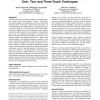CHI
2007
ACM
15 years 1 months ago
2007
ACM
This article presents an investigation of empathy within an online community for older people (SeniorNet). Qualitative content analysis of 400 messages from a discussion board abo...
CHI
2007
ACM
15 years 1 months ago
2007
ACM
Domestic ubiquitous computing systems often rely on inferences about activities in the home, but the open-ended, dynamic and heterogeneous nature of the home poses serious problem...
CHI
2007
ACM
15 years 1 months ago
2007
ACM
Software developers are rooted in the written form of their code, yet they often draw diagrams representing their code. Unfortunately, we still know little about how and why they ...
CHI
2007
ACM
15 years 1 months ago
2007
ACM
CHI
2007
ACM
15 years 1 months ago
2007
ACM
Today many workers spend too much of their time translating their co-workers' requests into structures that information systems can understand. This paper presents the novel ...
CHI
2007
ACM
15 years 1 months ago
2007
ACM
We investigate pointing at graphical targets of arbitrary shapes. We first describe a previously proposed probabilistic Fitts' law model [7] which, unlike previous models tha...
CHI
2007
ACM
15 years 1 months ago
2007
ACM
On traditional tables, people frequently use the third dimension to pile, sort and store objects. However, while effective and informative for organization, this use of the third ...
CHI
2007
ACM
15 years 1 months ago
2007
ACM
We present an observational study that was conducted to guide the design and development of technologies to support information flow during nurses' shift change in a hospital...
CHI
2007
ACM
15 years 1 months ago
2007
ACM
Using a stylus on a tablet computer to acquire small targets can be challenging. In this paper we present pointing lenses ? interaction techniques that help users acquire and sele...
CHI
2007
ACM
15 years 1 months ago
2007
ACM
Visual search is an important part of human-computer interaction. It is critical that we build theory about how people visually search displays in order to better support the user...




